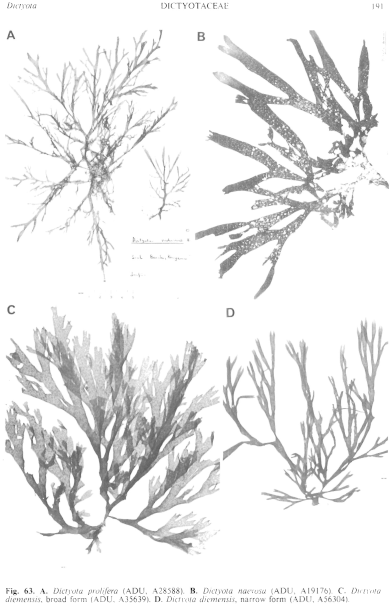|
|
|
|
|
|||||||||||
|
Electronic Flora of South Australia Species Fact Sheet
Phylum Phaeophyta – Order Dictyotales – Family Dictyotaceae – Tribe Dictyoteae
Selected citations: Womersley 1967: 209. 1). naevosa sensu Harvey 1862: pl. 186.
Reproduction: Tetrasporangia (Fig. 64F,G) (80–) 100–180 µm in diameter, grouped usually into conspicuous elongate-ovate to lenticular sori (Fig. 63C) 1–2 mm long and 0.5–1 mm across, centred around hair tufts, with other scattered sporangia. Oogonia in scattered, rounded to elongate-ovate, sori 1 50–400 (–700) µm long and 120–250 µm across; oogonia 50–80 µm long and 35–50 µm in diameter. Antheridia in scattered, elongate-ovate, sori 300–600 µm long and 200–300 µm across; antheridia 50–80 µm long and 20–35 µm in diameter.
Type from George Town, Tas. (Harvey); in Herb. Sonder, MEL, 17031.
Selected specimens: (all sporangial unless stated): Point Sinclair, S. Aust., upper sublittoral pool ( Womersley, 8.6.1954; ADU, A19554). Elliston, S. Aust., 7 m deep (Shepherd, 21.x.1970; ADU, A37540). Point Avoid, S. Aust., drift (Womersley, 2.xii.I 975; ADU, A46860). Pondalowie Bay, S. Aust., drift (Womersley, 9.xi.1980; ADU, A51859-"Marine Algae of southern Australia" No.253). Port Noarlunga, S. Aust., 3–5 m deep (Nielsen, 3.xii.1966; ADU, A30997). Aldinga, S. Aust., upper sublittoral (Womersley, 1.i.1965; ADU, A28575). Vivonne Bay, Kangaroo I., S. Aust., drift (Womersley, 2.i.1949; ADU, A10604). Judith Cove, West I., S. Aust., 3–5 m deep (Shepherd, 5.xi.1966; ADU, A31582, sporangial, female and male). Port Elliot, S. Aust., drift (Womersley, 31.xii.1984; ADU, A56304-"Marine Algae of southern Australia" No.253a). Lady Julia Percy I., Vic.. 8–13 m deep (Shepherd, 5.i.1968; ADU,
Distribution: From Point Sinclair, S. Aust. to Port Phillip Heads, Vic. and around Tasmania.
Taxonomic notes: Mathis (Fig. 63C.D) light brown to olive-brown, sometimes dark brown, (5–) 10–30 cm long with branches (2–) 5–10 (–14) mm broad, irregularly alternately to dichotomously branched at intervals of 1–5 cm and usually within 1–2 cm of the apices, branches usually broadening from their base upwards and tapering to rounded apices; proliferations occasional following damage. Holdfast of rhizoids; epilithic. Cortical cells (10–) 15–25 (–30) µm across, L/B 1–2 (–3), with the medullary cell outlines moderately conspicuous in older parts of dried specimens. Hair tufts scattered, hairs (8–) 10–15 µm in diameter.
A32325). Ulverstone, Tas., drift (Gordon, 18.i.1966; ADU, A30111, female and male). Marion Bay, Tas., 6 m and 10–12 m deep (Shepherd, 13.ii.1970; ADU, A35622 and A35639 resp.)
D. diemensis was separated by Kützing (1859, p.14) from the South African D. naevosa which Harvey (1862, pl. 186) had recorded from George Town, Tasmania. However, it now appears that D. naevosa (see above) occurs from Western Australia to Gulf St Vincent, S. Aust., while D. diemensis is essentially an eastern species. D. diemensis is variable in thallus dimensions, and specimens growing in rock pools are typically narrower (usually 3–6 mm broad-Fig. 63D) than deeper water specimens (6–12 mm broad-Fig. 63C); this applies even in Tasmania, where the broadest specimens (e.g. A35639) occur in deep water and narrow specimens (e.g. A301 1 I) are also known. The degree of association of sporangia into sori is also variable, but evident to some degree in all specimens, and the broad form usually has more frequent pedicel cells to the sporangia than the narrow forms.
The distinctions between D. naevosa and D. diemensis need further study, but the former has a dark brown, broader and usually larger thallus than the latter.
References:
HARVEY, W.H. (1862). Phycologia Australica. Vol. 4, Plates 181–240. (Reeve: London.)
KÜTZING, F.T. (1859). Tabulae Phycologicae. Vol. 9. (Nordhausen.)
WOMERSLEY, H.B.S. (1967). A critical survey of the marine algae of southern Australia. II. Phaeophyta. Aust. J. Bot. 15, 189–270.
The Marine Benthic Flora of Southern Australia Part II complete list of references.
Publication:
Womersley, H.B.S. (14 December, 1987)
The Marine Benthic Flora of Southern Australia
Part II
©Board of the Botanic Gardens and State Herbarium, Government of South Australia
Illustrations in Womersley Part II, 1997: FIGS 63C,D, 64F,G.

Figure 63 enlarge
Fig. 63. A. Dictyota prolifera (ADU, A28588). B. Dictyota naevosa (ADU, A19176). C. Dictyota dietnensis, broad form (ADU, A35639). D. Dictyota diemensis, narrow form (ADU, A56304).

Figure 64 enlarge
Fig. 64. A–D. Dictyota prolifera (A,B, ADU, A19576; C,D, ADU, A28588). A. Thallus with sporangial sori on opposite sides in concave undulations, with small proliferations. B. Transverse section of thallus with undivided sporangia. C. Thallus with male sori on opposite sides. D. Transverse section of male sorus with antheridia and paraphyses, and a young hair tuft from opposite surface. E. Dictyota naevosa (ADU, A13602). Transverse section of thallus with undivided sporangia. F. Dictyota diemensis, broad form (ADU, A35622). Transverse section of thallus with undivided sporangia. G. Dictyota diemensis, narrow form (ADU, A56304). Transverse section of thallus with undivided sporangia. H–M. Dictyota dichotoma (ADU, A26409). H. Surface view of branch with scattered sporangia and hair groups. I. Transverse section of thallus with sporangia. J. Surface view of branch with oogonial sori. K. Transverse section of thallus with an oogonial sorus. L. Surface view of an antheridial sorus with sterile peripheral paraphyses. M. Transverse section of thallus with an antheridial sorus.

|
Email Contact: State Herbarium of South Australia |

|